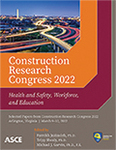Hiring for the New Age: Job Advertisements and the Transportation Workforce
Publication: Construction Research Congress 2022
ABSTRACT
As retirement rates of older workers increase, millennials have become the largest cohort within the transportation construction workforce. This transition to a younger workforce has resulted in the loss of institutional knowledge and issues regarding workforce resilience. There is a need, then, to hire new, younger employees and to build their institutional knowledge. There are noted differences between workers of different generations; these differences are a driving concern to human resource professionals. Job postings are the gateway to public agency recruitment, and the way they are written could affect their attraction to younger generations of workers. There are job characteristics that are more attractive to younger generations, such as work-life balance, flexible schedules, recognition as a valued contributor, and substantial opportunities for advancement and promotion. Utilizing these characteristics, the authors created a method of evaluation that can be used to rank job postings on their appeal to younger generations. The results of this study will help public agencies advertise to younger generations more effectively and improve their hiring success.
Get full access to this article
View all available purchase options and get full access to this chapter.
REFERENCES
AASHTO Editor. (2018). “Finding the future workforce for state DOTs becoming tougher.”.
Bizzi, L. (2018). The hidden problem of Facebook and social media at work: What if employees start searching for other jobs? Business Horizons, 61(1), 23–33.
Catano, V. M., and Hines, H. M. (2016). The Influence of Corporate Social Responsibility, Psychologically Healthy Workplaces, and Individual Values in Attracting Millennial Job Applicants. Canadian Journal of Behavioural Science, 48(2), 142–154.
Chan, Z., and Ho, S. (2019). Good and bad practices in rubrics: the perspectives of students and educators. Assessment & Evaluation in Higher Education, 44(4), 533–545.
Cho, J., Park, D. J., and Ordonez, Z. (2013). Communication-oriented person-organization fit as a key factor of job-seeking behaviors: Millennials’ social media use and attitudes toward organizational social media policies. Cyberpsychology, Behavior, and Social Networking, 16(11), 794–799.
Cotter, T. (2019). Writing job descriptions for hiring millennials. Recruiting Resources: How to Recruit and Hire Better. https://resources.workable.com/stories-and-insights/writing-job-descriptions-hiring-millennials.
Dheeraj, S. (2019). How to Recruit, Incentivize and Retain Millennials. Sage Publications Pvt. Ltd.
Dimock, M. (2019). Defining generations: Where Millennials end and Generation Z begins. Pew Research Center. http://tony-silva.com/eslefl/miscstudent/downloadpagearticles/defgenerations-pew.pdf.
Fry, R. (2018). Millennials are the largest generation in the U.S. labor force. Pew Research Center. https://www.pewresearch.org/fact-tank/2018/04/11/millennials-largest-generation-us-labor-force/.
Glagola, C., and Nichols, C. (2001). Recruitment and retention of civil engineers in departments of transportation. Leadership and Management in Engineering, 1(1).
Gallagher, S., and Villwock-Witte, N. (2016). Millennials in the Transportation Workforce. Transportation Research Record: Journal of the Transportation Research Board, 2552, 43–47.
Karakhan, A. A., Gambatese, J. A., and Simmons, D. R. (2020). Development of Assessment Tool for Workforce Sustainability. Journal of Construction Engineering and Management, 146(4).
Kelly, R. (2017, November 9). 7 Mistakes to Avoid When Writing a Job Description. Ongig Blog. https://blog.ongig.com/writing-job-descriptions/7-mistakes-to-avoid/.
Metro, K., Harper, C., and Bogus, S. M. (2021). Factors Affecting Workforce Resilience in Public Transportation Agencies. Journal of Management in Engineering, 37(4).
National Academies of Sciences, Engineering, and Medicine. (2019). Transportation Workforce Planning and Development Strategies. Washington, DC: The National Academies Press. https://doi.org/10.17226/25624.
Sickler, J., Bardar, E., and Kochevar, R. (2021). Measuring Data Skills in Undergraduate Student Work: Development of a Scoring Rubric. Journal of College Science Teaching, 50(4), 25–32.
Twenge, J. M. (2014). Generation me: why today’s young Americans are more confident, assertive, entitled--and more miserable than ever before. Atria Paperback, A Division of Simon & Schuster, Inc., New York.
Walvoord, B. E., and Anderson, V. J. (2010). Effective grading: A tool for learning and assessment in college. John Wiley & Sons.
Information & Authors
Information
Published In
History
Published online: Mar 7, 2022
Authors
Metrics & Citations
Metrics
Citations
Download citation
If you have the appropriate software installed, you can download article citation data to the citation manager of your choice. Simply select your manager software from the list below and click Download.
